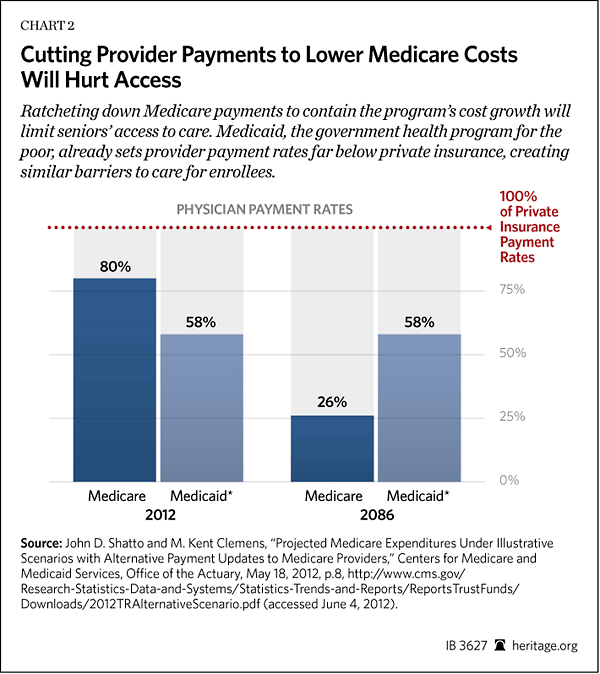Earlier this month, the Medicare trustees released their annual report on Medicare’s financial condition. The report did not offer much in the way of news—Medicare still faces a dismal future. But the really bad news came when Medicare’s Office of the Actuary released its alternative analysis. This report, based on more realistic assumptions, shows the program’s condition is likely to be much worse than estimated by the trustees.
A Program at Risk
Medicare has been running cash deficits since 2008, and according to the trustees, the Medicare Part A trust fund will be completely empty in 2024. As Heritage experts Bob Moffit and Rea Hederman explained in earlier analysis, “The trustees also say that these cash deficits will continue well into the future. If the Part A trust fund is indeed exhausted, it cannot pay for seniors’ hospital benefits.” [1] At that point, the situation would require Congress to increase taxes or allow for an automatic reduction in seniors’ benefits.
And that would be the best-case scenario for the Medicare program. The actuary’s alternative report, which uses more realistic assumptions, paints a much different picture. The actuary’s alternative scenario takes into consideration the fact that Congress is very unlikely to allow dramatic provider payment reductions to go into effect. The result: Medicare’s long-term unfunded obligations could be as high as $36.9 trillion—that is $10 trillion more than predicted by the trustees report.[2] To put this in perspective, $36.9 trillion is more than twice the size of the current national debt—and that is just for one entitlement program.

Why the Alternative Scenario Is More Realistic
The problem with the trustees’ analysis is that it assumes current law is enacted as written, even though this includes a number of cost-containment mechanisms in Medicare that would have tremendously adverse consequences for seniors’ access to care and the quality of Medicare as a meaningful source of health coverage. The actuary’s alternative report explains why these assumptions are unrealistic.
The Sustainable Growth Rate. In 2013, Medicare physician payments face a scheduled cut under the sustainable growth rate (SGR). Although Congress has continually delayed such cuts in the past, the trustees are forced to assume that Congress will allow a 30.9 percent pay cut for physicians to go into effect next year, followed by subsequent pay reductions in the years that follow. Under this scenario, the actuary warns that physicians’ payments for Medicare patients would be about 40 percent of private insurance payments by 2030 and continue to fall thereafter.[3]
Even if these drastic cuts were fully implemented, the trustees report still shows Medicare would be wildly unaffordable. Medicare Part B alone, which covers physician and outpatient services, would still present taxpayers with $14.7 trillion in long-term unfunded obligations.[4] As noted, this is the best-case scenario for Medicare.

Obamacare’s Medicare Productivity Adjustments. The SGR cuts are not the only source of unrealistic savings assumed in the trustees report. Obamacare introduced a similar cost-containment strategy for Medicare payments to inpatient and outpatient hospitals, skilled nursing facilities, and home health agencies. These cuts are also unlikely to be fully implemented. If they were, the actuary warns, Medicare would eventually pay inpatient hospitals just 39 percent of what private insurance pays. Furthermore, because of the cuts, 25 percent of affected providers would operate in the red in by 2030.[5]
Obamacare’s Medicare Independent Payment Advisory Board. Finally, Obamacare also set up the Independent Payment Advisory Board (IPAB) to control the growth in Medicare’s cost. This board of 15 unelected officials is in charge of making further cuts to Medicare providers if cost growth in the program exceeds the rate of growth of U.S. gross domestic product (GDP) plus 1 percent. But according to the actuary, if the scheduled payment reductions under the SGR and productivity adjustments do not go into effect, “reducing cost growth rates to the degree required by the IPAB provision would be challenging.”[6]
More Realistic Assumptions Make a Big Difference
In the alternative report, the actuary states, “[I]f these elements of current law are not sustained in all future years, then Medicare expenditures in 2080 could be about 50 percent greater than projected under current law.”[7] This alternative scenario assumes that the scheduled drastic Medicare physician payment reductions are replaced with a slight annual increase, the productivity adjustments in Obamacare are phased down, and IPAB’s recommended cuts do not go into effect.
Under the trustees’ assumptions, the actuary points out that the cost of Medicare Part A is expected to increase to 2.73 percent of GDP by 2080, a 60 percent increase compared to 2011.[8] In comparison, under the actuary’s alternative scenario, Part A will consume 4.14 percent of GDP in 2080—a 145 percent increase compared to 2011.[9]
The same is true for Part B: The alternative scenario shows that delaying physician payment updates according to the SGR alone would increase Part B expenditures by 9.4 percent in 2013 and 13.6 percent in 2021. When this is paired with a phase-down of the productivity adjustments and elimination of IPAB cuts, Part B would consume 4.39 percent of GDP by 2080, a 287 percent increase compared to 2011. In comparison, the trustees’ assumptions show that Part B would consume 2.52 percent of GDP by 2080, a 170 percent increase compared to 2011.
Reverse Course Now
The actuary’s report makes one thing crystal clear: Medicare, under either scenario, remains unsustainable. Medicare “as we know it” cannot continue. Even if Congress did allow current law to be enacted as written, ratcheting down provider payment rates cannot be done without consequences for patients. The actuary states, “In practice, providers could not sustain continuing negative margins and, absent legislative changes, would have to withdraw from providing services to Medicare beneficiaries, merge with other provider groups, or shift substantial portions of Medicare costs to their non-Medicare, non-Medicaid payers.”[10]
There is another option. Moving Medicare to a premium support model, paired with other reforms, could solve the problems facing the program in a way that is affordable for taxpayers and preserves access to quality coverage for America’s seniors.[11]
Kathryn Nix is a Policy Analyst in the Center for Health Policy Studies at The Heritage Foundation.

